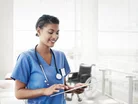Smart hospitals: Tech-driven asset tracking & optimisation

The case for digitalising healthcare has never been more urgent. Hospitals are under pressure; increasing demand for healthcare from an ageing global population, staff shortages and pressure to deliver ever-higher quality of care are driving a long-overdue revolution in the way healthcare infrastructure is operated. At the same time, new software business models are lowering the barrier to entry for technologies which can integrate IT, OT and medical systems to increase efficiency and flexibility, manage costs, maximise productivity and create better patient experiences. For hospitals, the time is now.
Many digital transformation initiatives fail and healthcare – with complex, fragmented infrastructure - is at particularly high risk of failure. To create connected care and improve operational and clinical results, it is imperative that technology is applied with a clear outcome in mind, to drive the vision of a smart hospital in which data from smart devices, such as tags and badges, is aggregated, analysed and used to promote data-driven decision making.
Location Intelligence and Real-Time Location Services (RTLS) are perfect examples. The concept of RTLS in hospitals is not a particularly new one, but to succeed it needs to be carefully implemented. The benefits are proven – an improved patient experience, better asset and staff efficiency and reduced operational and maintenance costs. RTLS needs to be a core element of a hospital’s digital transformation and, done right – implemented with clear outcomes in mind and integrated into a hospital’s digitalisation strategy - RTLS can pay back swiftly.
No more hide and seek
Research shows that hospital staff spend a significant amount of time looking for medical equipment, which is time that’s not focused on patient care. Add to this the fact that the utilisation rate of most hospital equipment is quite low, and accounting for some being lost and stolen during its lifetime, you have a clear business case for asset tracking via RTLS.
Tagged equipment can feed location and maintenance data to a hospital’s IoT systems via a hospital-wide lighting-based sensor network, meaning staff know exactly where to find what they need, increasing staff efficiency and improving the patient experience. By using status tags, it’s immediately clear whether the equipment is in use and what condition it’s in (for example, if it’s been cleaned, sanitised or recently serviced), and alarms can be triggered if inventory levels are running low or assets are moving out of a certain area. Improving the use rate of under-utilised assets in this way means lower investment and ongoing maintenance costs.
It's also possible to use this system to track patients as they make their way through their treatment journey at a hospital; a key part of ensuring that the patient experience is as smooth as possible and increasing patient flow. Patients are – quite rightly - demanding an increasingly digitalised healthcare experience which is in line with the rest of their digital lives, and integrating RTLS into a patient-facing app can pay huge dividends when it comes to patient flow and experience.
Ideally, a smart hospital experience would start at home, with the patient able to check in via an app, specifying room and even food preferences. On arrival they can be guided to an assigned parking space, and as they enter the hospital, the RTLS system guides them to the right area, and hospital staff are notified. App-based wayfinding is a crucial element of developing a smart hospital; not only does it enable patients to smoothly navigate complex hospital facilities, but it reduces the time burden on hospital staff who are otherwise manually checking in and searching for patients or giving directions.
Both patients and staff can receive real-time status updates on upcoming treatment and wait times, allowing improvements in patient flow, reductions in wait times and an increase in treatment capacity. Eventually, healthcare facilities can use trend data to determine further cost and efficiency savings, by optimising space and processes; for example, understanding which rooms or buildings are underutilised, and repurposing them.
The use cases for RTLS are manifold, and the journey to a true smart hospital is a complex process. The difficulties for digitalisation initiatives are rooted in a lack of holistic strategy. However, the use of an IoT lighting based system, such as that from Enlighted, part of the Siemens Xcelerator portfolio, provides a ready and integrated infrastructure for lighting, temperature control and RTLS resulting in greater sustainability, operational efficiency and controlled inventory.
Done correctly, RTLS can be a highly valuable addition to a hospital’s digital infrastructure, and easily scaled as needed. But tools like RTLS have to be implemented with a specific outcome in mind. Defining these outcomes clearly in advance allows for data to be intelligently applied to solving challenges, and for dialogue with those whose workflows will be affected (ideally positively), to ensure the change is embraced.
To succeed with this type of digital transformation, and benefit from the financial, experiential, and operational efficiency gains, technologies like RTLS must be integrated into an overarching IoT strategy which places data acquisition and analysis at its core. In this way, multiple technologies for use cases like energy saving, lighting control, better space utilisation and RTLS can be integrated as part of an overarching IoT solution, and careful integration planning will ensure these tools fit together appropriately.



